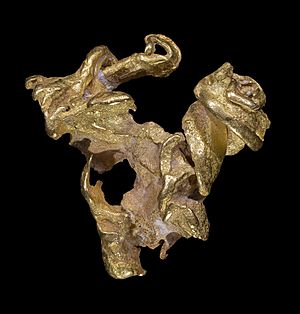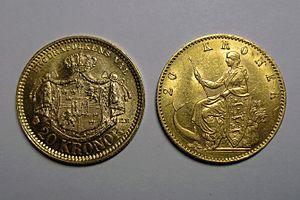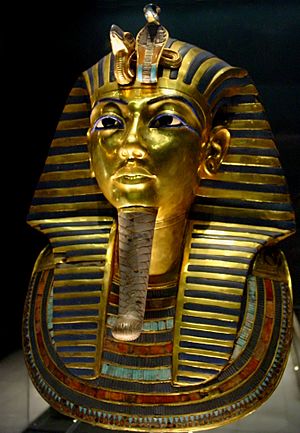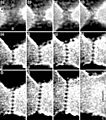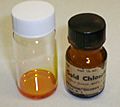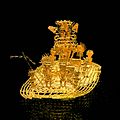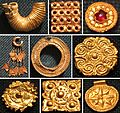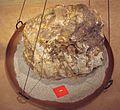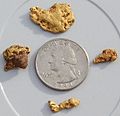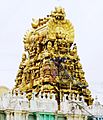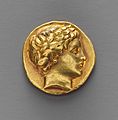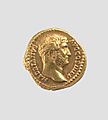Gold facts for kids
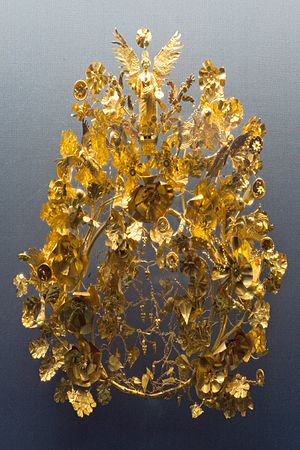
Gold is a soft, heavy, shiny metal. It is a chemical element. Its chemical symbol is Au. Its atomic number is 79. It has been used for many thousands of years by people all over the world, for jewelry, decoration, and as money. Gold is important because it is rare, but also easier to use than other rare metals. It is also used to repair teeth and in electronic equipment such as computers. The color of this metal is also called gold.
Mining methods for gold are similar to other metals. Gold is so valued that the discovery of a new place to mine has sometimes caused a gold rush.
Often, gold is found as a native element. This means it is not part of an ore, and does not need extracting.
Most of the gold on Earth is deep inside the Earth's core because it is dense. Nearly all discovered gold was deposited on the surface by meteorites.
Contents
Chemical properties
In chemistry, gold is chemical element 79, a transition metal in Group 11. It has an atomic weight of 199.96 a.m.u. Its symbol is Au, from the Latin word for gold, aurum. It is a "noble metal" meaning it has low chemical reactivity.
Gold is very soft. A goldsmith can hammer it into thin metal sheets. It is also ductile, which means it can be pulled into wire. When it is used in money or in jewelry, it is often alloyed with silver or some other metal to make it harder.
Most metals are gray in color. Gold is yellow because of the way its electrons behave. The only other metal in common use that has a non-gray color is copper.
Monetary use
Gold has been widely used throughout the world as money, for efficient indirect exchange (versus barter), and to store wealth in hoards. For exchange purposes, mints produce standardized gold bullion coins, bars and other units of fixed weight and purity.
The first known coins containing gold were struck in Lydia, Asia Minor, around 600 BC. The talent coin of gold in use during the periods of Grecian history both before and during the time of the life of Homer weighed between 8.42 and 8.75 grams. From an earlier preference in using silver, European economies re-established the minting of gold as coinage during the thirteenth and fourteenth centuries.
Bills (that mature into gold coin) and gold certificates (convertible into gold coin at the issuing bank) added to the circulating stock of gold standard money in most 19th century industrial economies.
After World War II gold was replaced by a system of nominally convertible currencies related by fixed exchange rates following the Bretton Woods system. Gold standards and the direct convertibility of currencies to gold have been abandoned by world governments, led in 1971 by the United States' refusal to redeem its dollars in gold. Fiat currency now fills most monetary roles. Switzerland was the last country to tie its currency to gold; it backed 40% of its value until the Swiss joined the International Monetary Fund in 1999.
Central banks continue to keep a portion of their liquid reserves as gold in some form, and metals exchanges such as the London Bullion Market Association still clear transactions denominated in gold, including future delivery contracts.
Many holders of gold store it in form of bullion coins or bars as a hedge against inflation or other economic disruptions.
History

Gold artifacts found at the Nahal Kana cave cemetery dated during the 1980s, showed these to be from within the Chalcolithic, and considered the earliest find from the Levant. Gold artifacts in the Balkans also appear from the 4th millennium BC, such as those found in the Varna Necropolis near Lake Varna in Bulgaria, thought by one source (La Niece 2009) to be the earliest "well-dated" find of gold artifacts. Gold artifacts such as the golden hats and the Nebra disk appeared in Central Europe from the 2nd millennium BC Bronze Age.
The oldest known map of a gold mine was drawn in the 19th Dynasty of Ancient Egypt (1320–1200 BC), whereas the first written reference to gold was recorded in the 12th Dynasty around 1900 BC. Egyptian hieroglyphs from as early as 2600 BC describe gold, which King Tushratta of the Mitanni claimed was "more plentiful than dirt" in Egypt. Egypt and especially Nubia had the resources to make them major gold-producing areas for much of history. One of the earliest known maps, known as the Turin Papyrus Map, shows the plan of a gold mine in Nubia together with indications of the local geology. The primitive working methods are described by both Strabo and Diodorus Siculus, and included fire-setting. Large mines were also present across the Red Sea in what is now Saudi Arabia.
Gold is mentioned in the Amarna letters numbered 19 and 26 from around the 14th century BC.
The legend of the golden fleece may refer to the use of fleeces to trap gold dust from placer deposits in the ancient world.
Gold is mentioned frequently in the Old Testament, starting with Genesis 2:11 (at Havilah), the story of The Golden Calf and many parts of the temple including the Menorah and the golden altar. In the New Testament, it is included with the gifts of the magi in the first chapters of Matthew. The Book of Revelation 21:21 describes the city of New Jerusalem as having streets "made of pure gold, clear as crystal". Exploitation of gold in the south-east corner of the Black Sea is said to date from the time of Midas, and this gold was important in the establishment of what is probably the world's earliest coinage in Lydia around 610 BC. From the 6th or 5th century BC, the Chu (state) circulated the Ying Yuan, one kind of square gold coin.
In Roman metallurgy, new methods for extracting gold on a large scale were developed by introducing hydraulic mining methods, especially in Hispania from 25 BC onwards and in Dacia from 106 AD onwards. One of their largest mines was at Las Medulas in León, where seven long aqueducts enabled them to sluice most of a large alluvial deposit. The mines at Roşia Montană in Transylvania were also very large, and until very recently, still mined by opencast methods. They also exploited smaller deposits in Britain, such as placer and hard-rock deposits at Dolaucothi. The various methods they used are well described by Pliny the Elder in his encyclopedia Naturalis Historia written towards the end of the first century AD.
During Mansa Musa's (ruler of the Mali Empire from 1312 to 1337) hajj to Mecca in 1324, he passed through Cairo in July 1324, and was reportedly accompanied by a camel train that included thousands of people and nearly a hundred camels where he gave away so much gold that it depressed the price in Egypt for over a decade, causing high inflation.
The European exploration of the Americas was fueled in no small part by reports of the gold ornaments displayed in great profusion by Native American peoples, especially in Mesoamerica, Peru, Ecuador and Colombia. The Aztecs regarded gold as the product of the gods, calling it literally "god excrement" (teocuitlatl in Nahuatl), and after Moctezuma II was killed, most of this gold was shipped to Spain. However, for the indigenous peoples of North America gold was considered useless and they saw much greater value in other minerals which were directly related to their utility, such as obsidian, flint, and slate. Rumors of cities filled with gold fueled legends of El Dorado.
Gold played a role in western culture, as a cause for desire and of corruption, as told in children's fables such as Rumpelstiltskin—where Rumpelstiltskin turns hay into gold for the peasant's daughter in return for her child when she becomes a princess—and the stealing of the hen that lays golden eggs in Jack and the Beanstalk.
The top prize at the Olympic Games and many other sports competitions is the gold medal.
75% of the presently accounted for gold has been extracted since 1910. It has been estimated that the currently known amount of gold internationally would form a single cube 20 m (66 ft) on a side (equivalent to 8,000 m3).
Golden treasures have been rumored to be found at various locations, following tragedies such as the Jewish temple treasures in the Vatican, following the temple's destruction in 70 AD, a gold stash on the Titanic, the Nazi gold train – following World War II.
The Dome of the Rock is covered with an ultra-thin golden glassier. The Sikh Golden temple, the Harmandir Sahib, is a building covered with gold. Similarly the Wat Phra Kaew emerald Buddhist temple (wat) in Thailand has ornamental gold-leafed statues and roofs. Some European king and queen's crowns were made of gold, and gold was used for the bridal crown since antiquity. An ancient Talmudic text circa 100 AD describes Rachel, wife of Rabbi Akiva, receiving a "Jerusalem of Gold" (diadem). A Greek burial crown made of gold was found in a grave circa 370 BC.
Culture
Great human achievements are frequently rewarded with gold, in the form of gold medals, gold trophies and other decorations. Winners of athletic events and other graded competitions are usually awarded a gold medal. Many awards such as the Nobel Prize are made from gold as well. Other award statues and prizes are depicted in gold or are gold plated (such as the Academy Awards, the Golden Globe Awards, the Emmy Awards, the Palme d'Or, and the British Academy Film Awards).
Aristotle in his ethics used gold symbolism when referring to what is now known as the golden mean. Similarly, gold is associated with perfect or divine principles, such as in the case of the golden ratio and the golden rule.
Gold is further associated with the wisdom of aging and fruition. The fiftieth wedding anniversary is golden. A person's most valued or most successful latter years are sometimes considered "golden years". The height of a civilization is referred to as a golden age.
In some forms of Christianity and Judaism, gold has been associated both with holiness and evil.
According to Christopher Columbus, those who had something of gold were in possession of something of great value on Earth and a substance to even help souls to paradise.
Wedding rings have been made of gold. It is long lasting and unaffected by the passage of time and may aid in the ring symbolism of eternal vows before God and the perfection the marriage signifies. In Orthodox Christian wedding ceremonies, the wedded couple is adorned with a golden crown (though some opt for wreaths, instead) during the ceremony, an amalgamation of symbolic rites.
Production
The World Gold Council states that as of the end of 2017, "there were 187,200 tonnes of stocks in existence above ground". This can be represented by a cube with an edge length of about 21 meters. At $1,349 per troy ounce, 187,200 metric tonnes of gold would have a value of $8.9 trillion.
As of 2017, the world's largest gold producer by far was China with 455 tonnes. The second-largest producer, Australia, mined 270 tonnes in the same year, followed by Russia with 250 tonnes.
Mining and prospecting
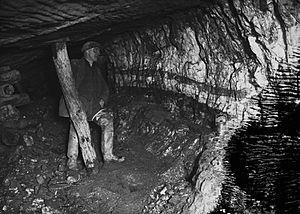
Since the 1880s, South Africa has been the source of a large proportion of the world's gold supply, and about 50% of the gold presently accounted is from South Africa. Production in 1970 accounted for 79% of the world supply, about 1,480 tonnes. In 2007 China (with 276 tonnes) overtook South Africa as the world's largest gold producer, the first time since 1905 that South Africa has not been the largest.
As of 2014, China was the world's leading gold-mining country, followed in order by Australia, Russia, the United States, Canada, and Peru. South Africa, which had dominated world gold production for most of the 20th century, had declined to sixth place. Other major producers are the Ghana, Burkina Faso, Mali, Indonesia and Uzbekistan.
In South America, the controversial project Pascua Lama aims at exploitation of rich fields in the high mountains of Atacama Desert, at the border between Chile and Argentina.
Today about one-quarter of the world gold output is estimated to originate from artisanal or small scale mining.
The city of Johannesburg located in South Africa was founded as a result of the Witwatersrand Gold Rush which resulted in the discovery of some of the largest natural gold deposits in recorded history.
During the 19th century, gold rushes occurred whenever large gold deposits were discovered. The first documented discovery of gold in the United States was at the Reed Gold Mine near Georgeville, North Carolina in 1803. The first major gold strike in the United States occurred in a small north Georgia town called Dahlonega. Further gold rushes occurred in California, Colorado, the Black Hills, Otago in New Zealand, Australia, Witwatersrand in South Africa, and the Klondike in Canada.
Images for kids
-
A gold nugget of 5 mm (0.20 in) in size can be hammered into a gold foil of about 0.5 m2 (5.4 sq ft) in area.
-
Schematic of a NE (left) to SW (right) cross-section through the 2.020-billion-year-old Vredefort impact structure in South Africa and how it distorted the contemporary geological structures. The present erosion level is shown. Johannesburg is located where the Witwatersrand Basin (the yellow layer) is exposed at the "present surface" line, just inside the crater rim, on the left. Not to scale.
-
An Indian tribute-bearer at Apadana, from the Achaemenid satrapy of Hindush, carrying gold on a yoke, circa 500 BC.
-
The Muisca raft, between circa 600-1600 AD. The figure refers to the ceremony of the legend of El Dorado. The zipa used to cover his body in gold dust, and from his raft, he offered treasures to the Guatavita goddess in the middle of the sacred lake. This old Muisca tradition became the origin of the legend of El Dorado. This Muisca raft figure is on display in the Gold Museum, Bogotá, Colombia.
-
An early mention of gold in the Beowulf
-
The Agusan image, depicting a deity from northeast Mindanao.
-
Relative sizes of an 860 kg (1,900 lb) block of gold ore and the 30 g (0.96 ozt) of gold that can be extracted from it, Toi gold mine, Japan.
-
Gold prospecting at the Ivalo River in the Finnish Lapland in 1898
-
Gold Nuggets found in Arizona.
-
Moche gold necklace depicting feline heads. Larco Museum Collection, Lima, Peru.
-
A 21.5k yellow gold pendant watch so-called "Boule de Genève" (Geneva ball), ca. 1890.
-
Cake with gold decoration served at the Amstel Hotel, Amsterdam
-
Mirror for the James Webb Space Telescope coated in gold to reflect infrared light
-
Kamakshi Amman Temple with golden roof, Kanchipuram.
-
Minoan jewellery; 2300–2100 BC; various sizes; Metropolitan Museum of Art (New York City)
-
Pair of Sumerian earrings with cuneiform inscriptions; 2093–2046 BC; Sulaymaniyah Museum (Sulaymaniyah, Iraq)
-
Ancient Egyptian statuette of Amun; 945–715 BC; gold; 175 mm × 47 mm (6.9 in × 1.9 in); Metropolitan Museum of Art
-
Ancient Egyptian signet ring; 664–525 BC; gold; diameter: 30 mm × 34 mm (1.2 in × 1.3 in); British Museum (London)
-
Ancient Greek stater; 323–315 BC; 18 mm (0.71 in); Metropolitan Museum of Art
-
Etruscan funerary wreath; 4th–3rd century BC; length: 333 mm (13.1 in); Metropolitan Museum of Art
-
Pre-Columbian pendant with two bat-head warriors who carry spears; 11th–16th century; gold; overall: 76.2 mm (3.00 in); from the Chiriqui Province (Panama); Metropolitan Museum of Art
-
English Neoclassical box; 1741; overall: 44 mm × 116 mm × 92 mm (1.7 in × 4.6 in × 3.6 in); Metropolitan Museum of Art
See also
 In Spanish: Oro para niños
In Spanish: Oro para niños


